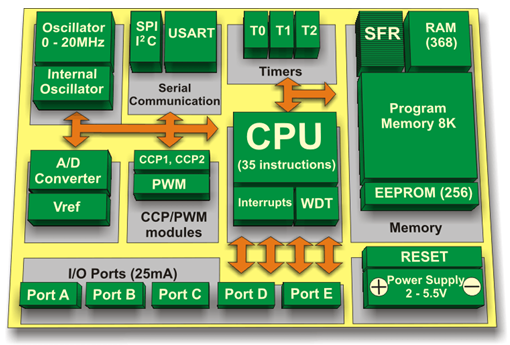The Peripheral Interface Controller (PIC), developed by Microchip, stands out among microcontrollers for its speed and ease of implementation compared to alternatives like the 8051. Its programming simplicity and seamless interfacing with other peripherals have contributed to its success.
A microcontroller, an integrated chip comprising RAM, ROM, CPU, timers, counters, etc., PIC shares these features along with additional components such as ADC (analog-to-digital converters) and DAC (digital-to-analog converters). PIC also facilitates interfacing with peripherals through protocols like CAN, SPI, and UART. Employing a modified Harvard architecture and supporting RISC (Reduced Instruction Set Computer), PIC demonstrates superior speed compared to 8051 microcontrollers, which adopt Von Neumann architecture.
PIC Microcontroller Architecture
CPU
The CPU in a PIC microcontroller, comprising Arithmetic Logic Unit (ALU), Memory Unit (MU), Control Unit (CU), Accumulator, etc., functions similarly to other microcontrollers. ALU handles arithmetic operations and logical decisions, while memory stores and processes instructions. The Control Unit manages both internal and external peripherals connected to the CPU. PIC’s support for RISC architecture ensures:

– A limited set of instructions (~35), reducing program complexity.
– Short, fixed-length instructions for consistent processing time.
– Faster processing due to shorter instructions.
– Simplified compiler requirements, easing debugging.
Memory
The memory module in a PIC includes RAM, ROM, and STACK.
RAM
Divided into banks, RAM registers encompass General Purpose Registers (GPR) and Special Purpose Registers (SPR). GPRs serve general functions, while SPRs have specific, vendor-defined purposes.
ROM
Holding instructions permanently, ROM, also known as program memory, stores programs written by users. Variants like EEPROM and Flash Memory offer reprogrammable capabilities.
Stack
During interrupts, the current process address is stored in the stack, allowing the PIC to resume execution after handling the interrupt.
Bus
Comprising data and address buses, PIC facilitates data transfer and memory address transmission between peripherals and the CPU. I/O pins enable interfacing with external peripherals, while UART and USART support serial communication with devices like GPS and Bluetooth.
Advantages of PIC Microcontroller
– High reliability and minimal malfunctioning due to RISC architecture.
– Low power consumption compared to other microcontrollers.
– Simplified interfacing and direct connection of analog devices.
– Easy programming experience for developers.
Disadvantages of PIC Microcontroller
– Larger program size due to RISC architecture’s limited instruction set.
– Limited accessibility to program memory and presence of a single accumulator.
Follow this link for complete project: Navigating the Components of PIC Microcontroller Architecture
